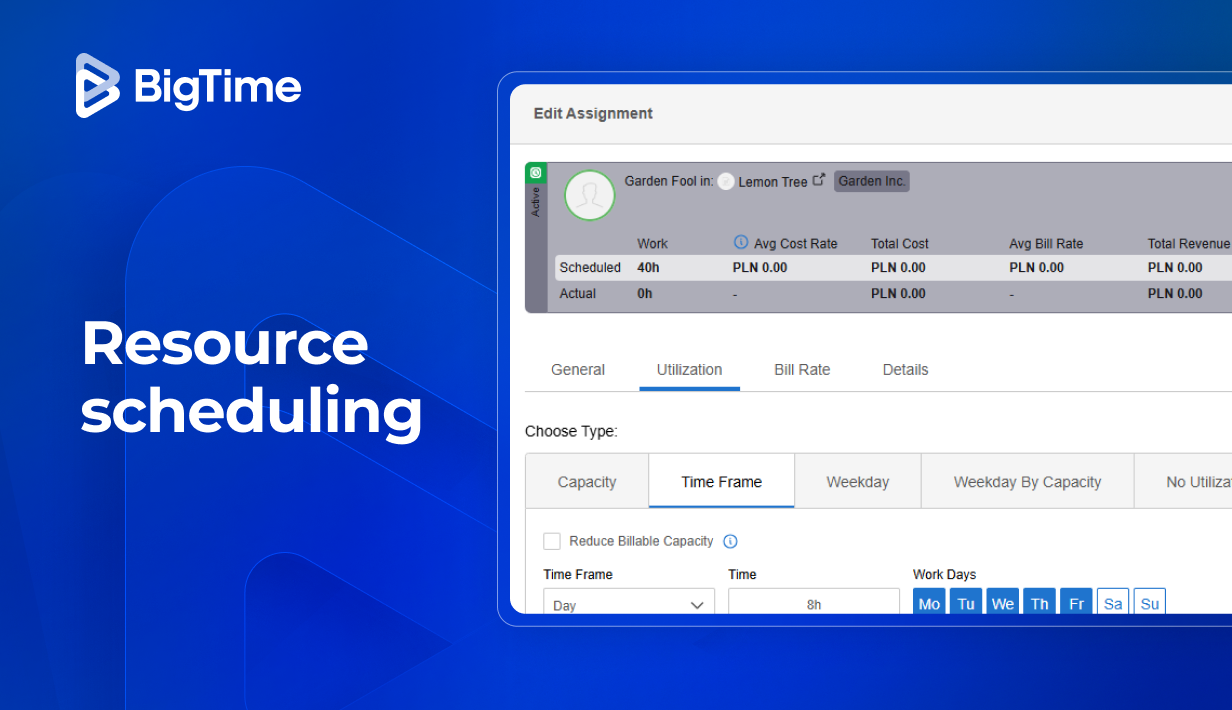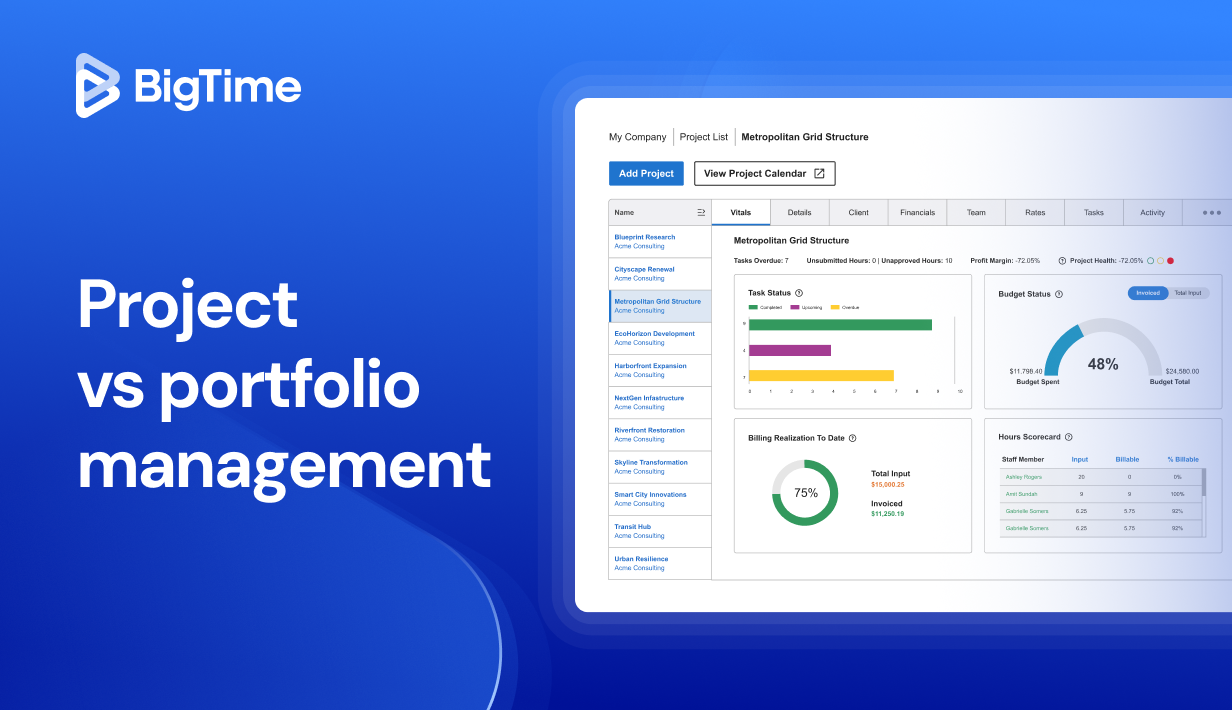Last update: July 18, 2025
What is resource scheduling? An absolute must for professional services organizations! Resource scheduling can help boost project profitability, ensure deadlines are met, and maintain reasonable workloads.
Keep on reading to learn more about resource scheduling and how it can help keep your bottom line, team, and clients happy.
What’s in this article?
- The definition of resource scheduling
- The benefits of resource scheduling
- The best resource scheduling methods
- Practical resource scheduling tips
What Is Resource Scheduling? Definition
Resource scheduling is the process of determining when and how project resources will be utilized and allocated.
To get more in depth, resource scheduling involves the strategic allocation and management of resources, such as time and materials to ensure effective project execution and client satisfaction. It plays a crucial role in optimizing resource utilization, meeting project deadlines, delivering high-quality services, and reducing burnout.
Benefits of Resource Scheduling
When you have a resource scheduling process in place that includes resource scheduling software, your organization will quickly see the following benefits.
1. Improved Project Quality
Maintain and enhance project quality by ensuring that the right resources with the appropriate skills and expertise are assigned to projects. This helps deliver high-quality results and meet client expectations consistently.
2. Consistent and Transparent Scheduling
Enable uniform scheduling practices across the organization with enterprise-wide visibility. This promotes transparency, collaboration, and effective coordination of resources, leading to smoother project execution.
3. Proactive Capacity Planning Based on Data Insights
Empower proactive capacity planning by leveraging data-driven insights. Project managers can anticipate resource demands, identify potential capacity constraints, and make informed decisions to allocate resources effectively and avoid bottlenecks.
4. Increased Productivity Through Optimized Resource Utilization
Enhance productivity by ensuring optimal utilization of resources. By assigning resources efficiently to tasks, organizations can maximize output, minimize downtime, and achieve project goals more efficiently.
5. Reduced Project costs with real-time financial reports
Resource scheduling, coupled with real-time financial reports that are offered with resource scheduling tools, allows organizations to monitor project costs closely. This proactive approach helps identify potential cost overruns early on, enabling effective cost control measures and ensuring projects stay within budget.

What Resource Scheduling Methods Could be Used To Simplify The Process?
Proper resource scheduling requires a systematized approach to human resources, project tasks, task dependencies, and, last but not least, successful project delivery. All those benefits cannot be achieved only with a resource management tool – the right methods can help you even more. Here are the most popular of them!
Critical Path Method (CPM)
The Critical Path Method (CPM) is one of the most widely used resource scheduling techniques in effective resource scheduling. It identifies the longest sequence of dependent tasks that determine the shortest time in which a project can be completed.
CPM helps managers allocate critical resources efficiently by prioritizing tasks that directly impact project deadlines. If any task on the critical path is delayed, the entire project timeline is affected. This method is particularly useful for large-scale construction, engineering, and IT projects, ensuring that resources are assigned to the most time-sensitive activities first.
Resource Leveling
Resource Leveling is a scheduling approach that aims to balance resource workloads and avoid over-allocation. Instead of strictly following the earliest possible start dates for tasks, resource leveling adjusts the schedule to prevent resource bottlenecks. This method may extend project duration but ensures that resources are used efficiently without overburdening team members or exceeding capacity limits. It is commonly applied in industries with limited resources, such as manufacturing, healthcare, and construction, where resource availability dictates project feasibility.
Agile Resource Scheduling (Scrum/Kanban)
Agile resource scheduling, particularly in methodologies like Scrum and Kanban, is highly popular in fast-paced and dynamic industries such as software development. Agile scheduling focuses on flexibility, iterative progress, and continuous reassessment of resource allocation. Instead of following a rigid project plan, teams dynamically adjust workloads based on evolving priorities, ensuring that high-value tasks receive immediate attention. Scrum organizes work in sprints, while Kanban uses visual boards to manage workflow efficiently. This method maximizes productivity, adaptability, and responsiveness to change.
4. Critical Chain Project Management (CCPM)
Critical Chain Project Management (CCPM) builds upon CPM by emphasizing resource constraints rather than just task dependencies. It accounts for limited available resources and uses buffer management to safeguard project schedules from delays. Unlike CPM, which assumes unlimited resources, CCPM prioritizes key resources and strategically places buffers to absorb unexpected disruptions. This method is highly effective in industries where resource availability is a challenge, such as aerospace, defense, and large-scale manufacturing, ensuring that critical tasks are completed without unnecessary delays.
These four methods—CPM, resource leveling, Agile scheduling, and CCPM—are among the most effective and widely used strategies in modern resource allocation. Their application varies depending on project complexity, industry needs, and resource capacity. Would you like help in selecting the best method for a specific project?

Resource Scheduling Tips
By following these tips, professional services organizations can optimize their scheduling and make the most of their resource pool.
Utilize Resource Management Software
Take advantage of resource management software. This kind of software can streamline the resource scheduling process and improve overall efficiency.
Optimize Resource Assignments
Carefully assign tasks to resources based on their skills, expertise, and availability. Optimal resource assignments maximize productivity and contribute to successful project outcomes.
Determine Resource Requirements
Understanding resource requirements ensures that the right amount of resources is allocated, preventing overstaffing or understaffing.
Implement Resource Leveling
Employ resource leveling techniques to balance workloads and avoid resource overloads or underutilization. Resource leveling ensures a smoother distribution of tasks and optimizes resource utilization.
Consider Constraints
Take into account any constraints or limitations that may impact scheduling, such as resource availability, skill requirements, budget constraints, or external dependencies.
Manage Resource Availability
Monitor and control the availability of resources to ensure they are allocated when needed.
Resource Scheduling: What to Keep in Mind
By keeping the following factors in mind, you can effectively schedule resources, optimize scheduling decisions, and ensure successful project execution.
Resource Capacity Planning
Evaluate the total workload that can be handled by your organization’s existing resources.
Resource Utilization
Measure the current utilization of resources within your company, which serves as a key performance indicator.
Resource Forecasting
Estimate future resource requirements for your project using resource scheduling software available for resource forecasting.
Resource Availability
Determine the resources that are available and accessible for your project, taking into account your capacity planning and utilization.
Project Schedule Alignment
Ensure that your resource schedule aligns with the project schedule and vice versa. Consider your resource capacity, and utilization when creating the project schedule.
Resource Scheduling Software
Professional Services Automation (PSA) software like BigTime offers significant advantages for resource scheduling in professional services organizations.
BigTime provides centralized visibility into resource availability, enhances decision-making with real-time data, and helps deliver projects on time and within budget. With this dynamic resource scheduler, you can:
- Quickly check people’s availability and find people ready for new assignments in seconds.
- Manage people’s skills and qualifications and use those qualities to find the best people for the job – every time.
- Use Gantt chart tools to quickly edit assignments and monitor any changes your colleagues make.
- Monitor how every new allocation impacts your project budget, thanks to pre-defined hourly rates for every employee.
- Analyze the productivity of your specialists and many other key performance indicators with advanced, AI-powered reporting.
Book a demo with BigTime’s expert to see what else we can do for you.





